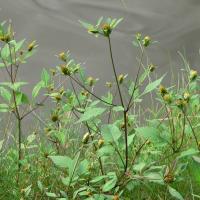Three-lobe beggarticks
Bidens tripartita
Bidens tripartita, commonly known as three-lobe beggarticks or trifid bur-marigold, is an annual flowering plant belonging to the Asteraceae family. It is native to Eurasia and can be found in various wetland habitats, including marshes, stream banks, and damp meadows. Here is an informative description of Bidens tripartita, including its characteristics and ecological significance:
Description:
-
Growth Form: Three-lobe beggarticks is an erect annual plant that can reach heights of 30 to 90 centimeters.
-
Leaves: The leaves are opposite, pinnately divided into three lobes (trifoliate), and toothed along the margins. The leaf arrangement gives the plant its specific epithet "tripartita."
-
Stems: The stems are often reddish-brown and have fine hairs.
-
Flowers: The flowers are small and yellow, with a daisy-like appearance. They are borne in clusters at the tips of the stems.
-
Fruit: The fruit is a small, flattened achene equipped with two or more barbed awns or hooks. These hooks aid in seed dispersal by attaching to fur or clothing.
Ecological Significance:
-
Habitat: Three-lobe beggarticks is commonly found in wetland habitats, including marshes, ditches, and the edges of ponds or streams. It can tolerate both flooded and moist conditions.
-
Wildlife: The plant provides habitat and food for various insects, including bees and butterflies. Birds may also feed on the seeds.
-
Seed Dispersal: The hooked seeds are well-adapted for dispersal. They attach to passing animals or human clothing, facilitating the spread of the plant to new areas.
Invasive Potential:
- While Bidens tripartita is not generally considered highly invasive, it can become weedy in certain wetland and disturbed habitats. Its ability to produce numerous seeds and its adaptability to various moisture conditions contribute to its potential for colonization.
Cultural Uses:
- Historically, some indigenous communities used parts of the plant for medicinal purposes. However, caution should be exercised, and any traditional uses should be validated through proper research.
Management:
-
In cultivated areas or where control is desired, manual removal by pulling or cutting can be effective, especially before the plant sets seed.
-
Preventing seed dispersal by avoiding contact with clothing or equipment in infested areas can help control the spread of the plant.
-
Herbicides labeled for aquatic or wetland environments may be used, following proper guidelines and regulations.











